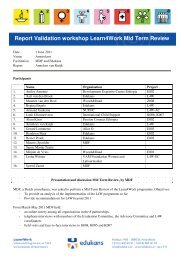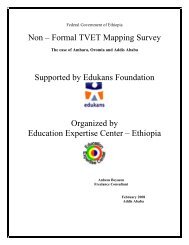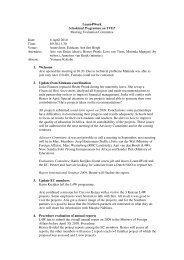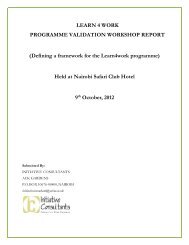DRAFT TECHNICAL AND VOCATIONAL EDUCATION AND ...
DRAFT TECHNICAL AND VOCATIONAL EDUCATION AND ...
DRAFT TECHNICAL AND VOCATIONAL EDUCATION AND ...
You also want an ePaper? Increase the reach of your titles
YUMPU automatically turns print PDFs into web optimized ePapers that Google loves.
10<br />
Dressmaking, Refrigeration and Air-conditioning, and Blocklaying and Concreting” (Duodu,<br />
2006). The project provided training to master craftsmen and women and apprentices. In<br />
addition, it made available modern working tools and equipment that were sold to<br />
apprentices, participating institutions, master craftsmen and women and the trade associations<br />
involved at low cost.<br />
Department for International Development (DFID). DFID and other donors have<br />
produced a Harmonisation Action Plan based on the Paris Declaration. DFID supports<br />
sectoral programmes which includes education. TVET forms part of British development<br />
assistance which includes budgetary support, but the GoG is left to decide how to use it and it<br />
is expected that some of the funds would be used for TVET. DFID is concerned with skill<br />
development in a broader sense than TVET.<br />
International Labour Organisation (ILO). ILO-‘s Ghana’s involvement in TVET related to<br />
the broad programme objective of Time Bound Programme for the Elimination of the Worst<br />
Forms of Child Labour. ILO’s involvement is centred on (a) education depending upon age<br />
and interest of the child, and (b) skills and vocational training.<br />
International Fund for Agricultural Development (IFAD of the U.N.). The IFADsupported<br />
Rural Enterprise Project is establishing and expanding self-employment<br />
and micro-enterprise through vocational training and skill development interventions.<br />
During the short field work for this review, NVTI reported that it was being assisted by the<br />
Danish Hairdressers Association to develop CBT curricula and train hairdressers for<br />
improved quality service delivery. The Danish group comes to Ghana for short periods to<br />
conduct its programmes. Also, NVTI gets sponsorship from India and China for some of<br />
their instructors to upgrade their skills for short periods in those countries.<br />
2.6 Demand and Supply<br />
The demand for TVET in Ghana is strong but the supply side is weak and has low capacity.<br />
There is strong demand for skill training, especially at the artisan, craft, and technician levels.<br />
This strong demand is due primarily to the size of the youthful population of Ghana and the<br />
growing expansion in universal basic education. According to the 2000 population census the<br />
0-14 year age group constituted 44.3% of the total population, and the growth rate was 2.7<br />
(see Appendix B). As Junior High School enrolment has reached the 1.2 million level, it<br />
means that on average about 400,000 young people will complete basic education each year<br />
and must move on to Senior High School (SHS) or seek skill training for future employment.<br />
About 65% of that number cannot enter SHS. Then there are the dropouts from basic and the<br />
cumulated numbers from previous years whose options are skill training or entry into the<br />
labour market without skills. Among those who complete SHS, only about 40% will enter the<br />
university or the polytechnic; the rest must enter the labour market or seek some form of skill<br />
training. The overwhelming demand for education and training at all levels has distorted the<br />
difference between social demand for TVET and economic demand for TVET. Some<br />
institutions talk of “demand-driven programmes” by which they mean programmes which<br />
parents and students are willing to pay for.<br />
One disturbing aspect of the demand for skill training is that the quality of basic academic<br />
skills (literacy and numeracy) with which prospective trainees seek admission is very low, as<br />
reported in the Education Sector Performance Report, 2008:<br />
Thus, the effective level of literacy (e.g. proficiency in English on the NEA) achieved<br />
is 26.1% of the 85% of the population that attained P6. This is 12.3%. Thus less







